Hands up who’s never been in a Toyota Hiace? Let’s be honest; there’s not many of us that haven’t. Toyota mentioned last year that a high percentage of the Hiaces registered new in New Zealand are still registered for the road. That’s a pretty impressive claim to fame.
There’s no denying that it’s one popular van, but perhaps overshadowed lately by the Ford Transit and fancy ‘newcomers’ like the Hyundai iLoad. Of course we’ve got Euro options in vans too, and these are chipping away at the Hiace’s market share.
With the Hiace the only van still using a cab-over design, it was time to step up its game, and after 14 years of the previous generation, this year Toyota have given us a completely redesigned Hiace, now with a safer frontal design, like its competitors.
Will tradies still love it? Will it bring Transit and iLoad buyers back to the Hiace? We spent a week with one to find out.
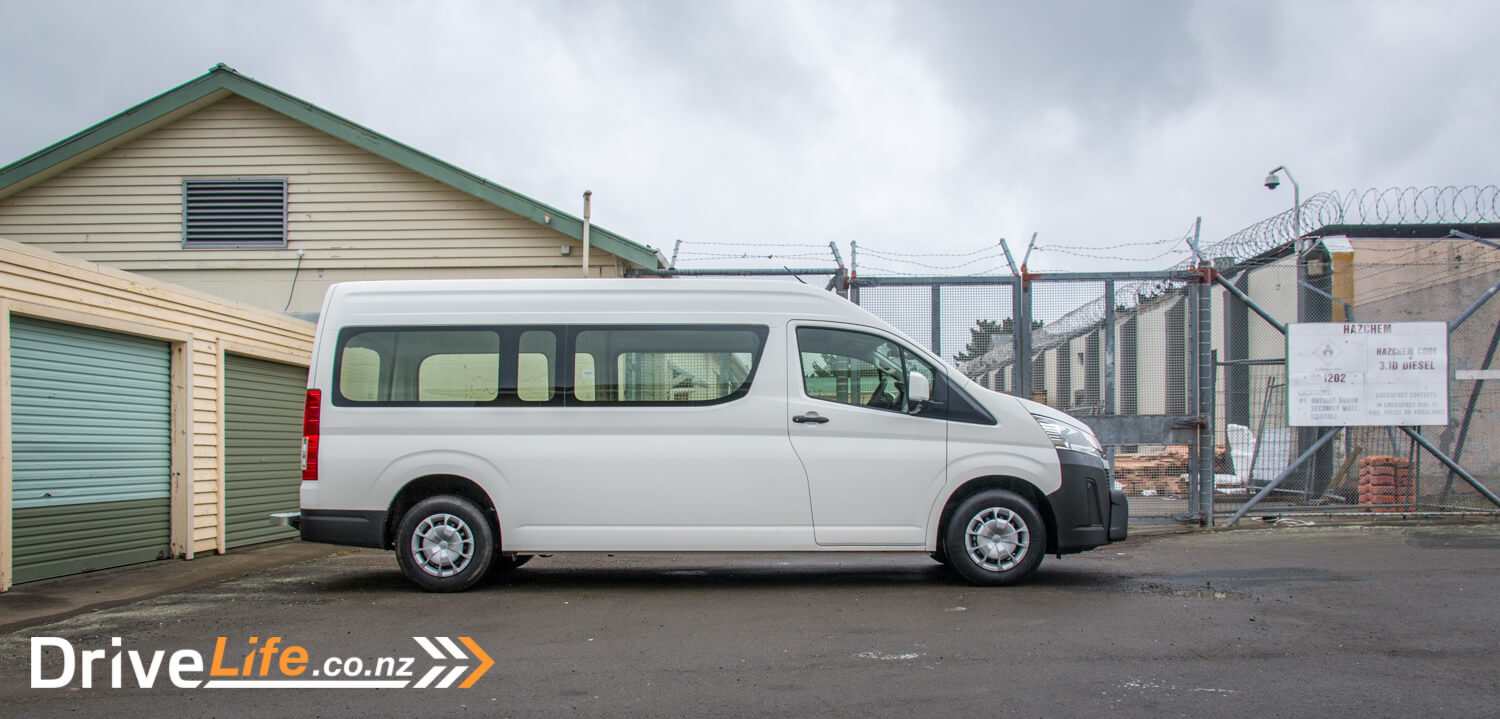
The Range
You get to pick from 4 models of Hiace in the new generation; the base ZR model comes with a manual or automatic transmission, while the rest are all automatics.
All are fitted with a 2.8-litre diesel turbo motor, pumping out 130kW of power and 420Nm of torque (manual) or 450Nm of torque (automatic). The manual gearbox is a 6-speed, as is the automatic.
You can see by the pricing table that it’s mainly the body style that is the difference, with 3 models being ZR and only one top-spec ZX model.
Standard features include a limited slip differential, 7 airbags (driver and passenger front, front seat side, driver’s knee, front curtain shield airbags), Blind Spot Monitor, Rear Cross Traffic Alert, Brake Assist, Emergency Stop Signal, Hill-start Assist, Secondary Collision Brake, Adjustable Speed Limiter, Drive-Start Control, Trailer Sway Control, reversing camera with dynamic guidelines, and 2x front, 4x rear park sensors. DRLs are included, as is cruise control, power folding and heated mirrors, an auto-dimming rear-view mirror, a 7” central touchscreen display, SatNav with SUNA traffic updates.
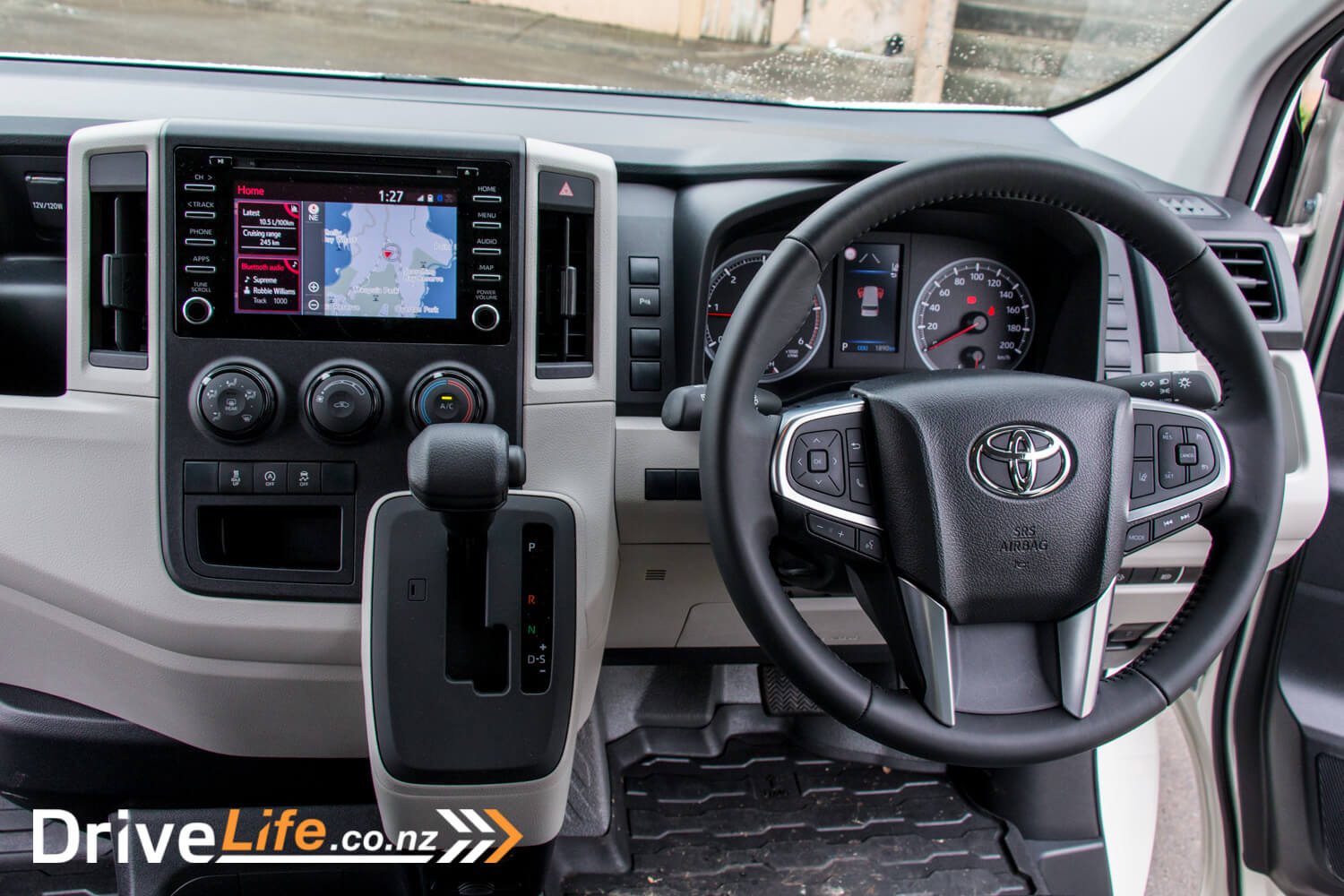
Standard safety features include Toyota Safety Sense, which means Pre-Collision System with Autonomous Emergency Braking, Vehicle and Pedestrian daytime and night-time, Bicyclist daytime detection, Automatic High Beams, Lane Departure Alert with Yaw Assist (Brake Control) and Vehicle Sway Warning function, and Road Sign Assist.
There’s four colour options in the new model; Quicksilver, French Vanilla, Magma Red, or Beige Metallic (ZX only).
Pricing (driveaway):
- 2.8 TD Hiace ZR 5 Door Van – 2 Seat MT $44,990
- 2.8 TD Hiace ZR 5 Door Van – 2 Seat AT $46,990
- 2.8 TD Hiace ZR 5 Door Half Panel Van – 5 Seat AT $47,990
- 2.8 TD Hiace ZR Minibus 4 Door Van – 10 Seat AT $52,990
- 2.8 TD Hiace ZX 4 Door Van – 2 Seat AT $50,990
You can read more about the Hiace on Toyota New Zealand’s website.
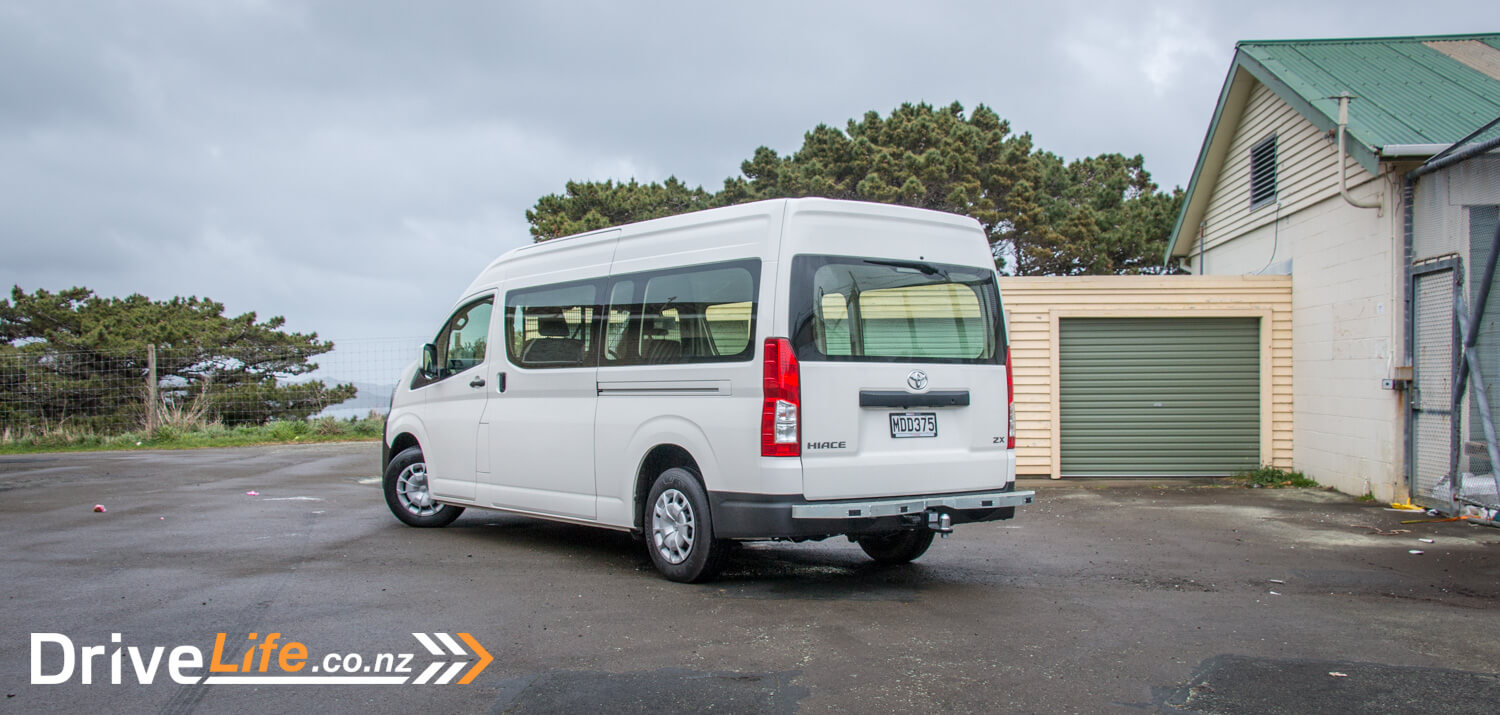
First Impressions
There’s a reason New Zealanders love the previous generation of Hiace; it looks freaking good. How many times have we seen a blinged-up Hiace courier van? Plenty. The thing is, the latest safer design for vans is never going to look as good as cab-over. But it’s not like Toyota had a choice; vehicle safety regulations meant that the entire design had to change
Does it still look good? I’m on the fence here. Some angles at the front, yes. At other times, it just seems too much bumper and not enough design. Toyota considers it “more powerful looking”.
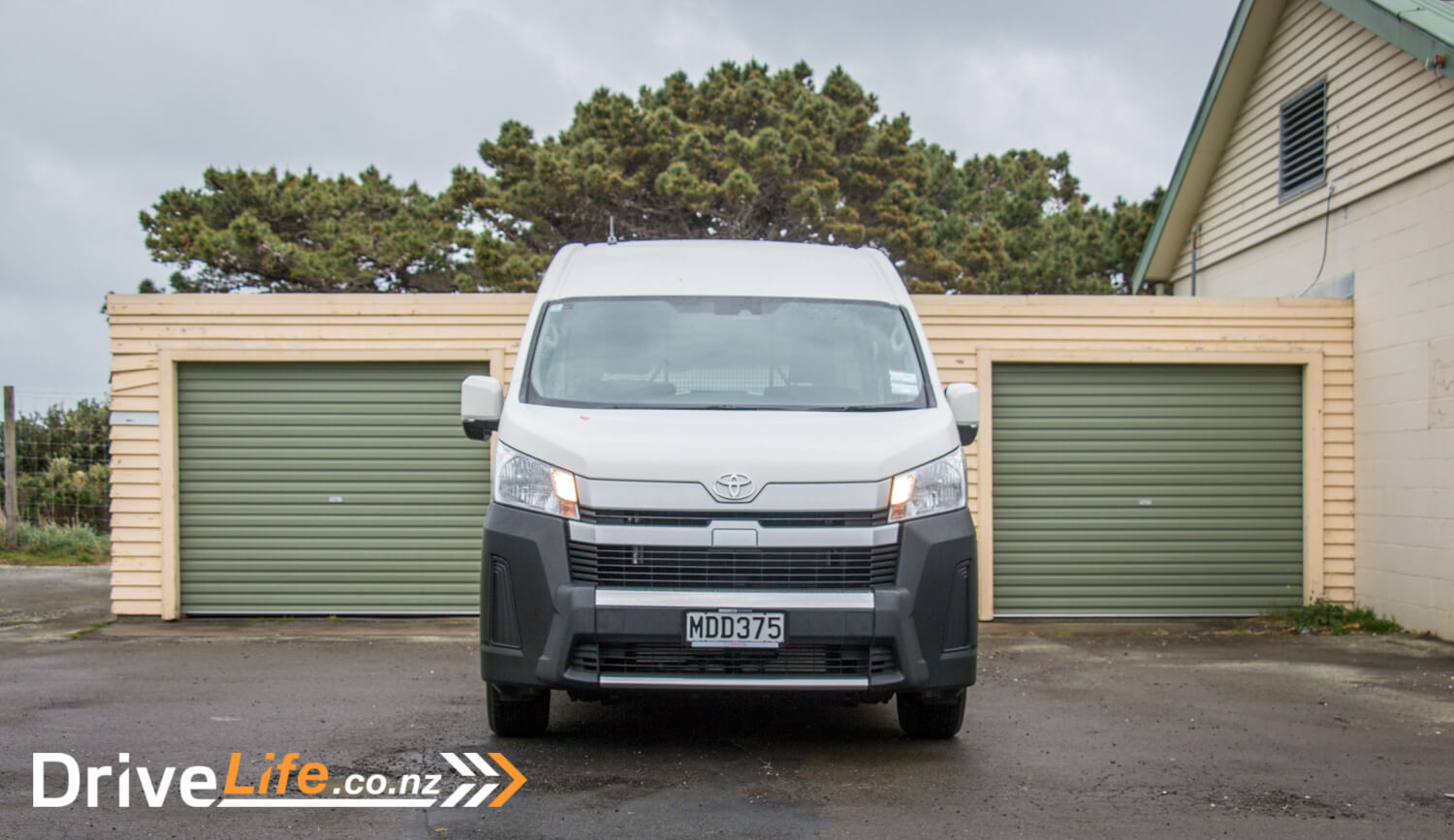
It doesn’t look bad, but I don’t think any amount of bling is going to make it look as good as the outgoing model. Still, for lots of van buyers it’s function over form.
The Inside
Then you get to the inside. The Hiace has gone modern, with a big central touchscreen display, a leather steering wheel and a nice two-tone mix of plastics in the cabin. The headlining is beige and along with that massive windscreen, helps to lift the whole interior of the van. It’s super-light and airy inside. It still feels very functional and van-like, but it’s very nicely done.
For the Hiace to achieve a 5 Star ANCAP rating, the middle seat had to go. In the place of a middle seat is a huge plastic bin, with a removable divider to stop your stuff floating about. You can fit a fair amount of stuff down there. Our test van had a steel mesh screen behind the front seats, but without this you could easily walk through to the rear.
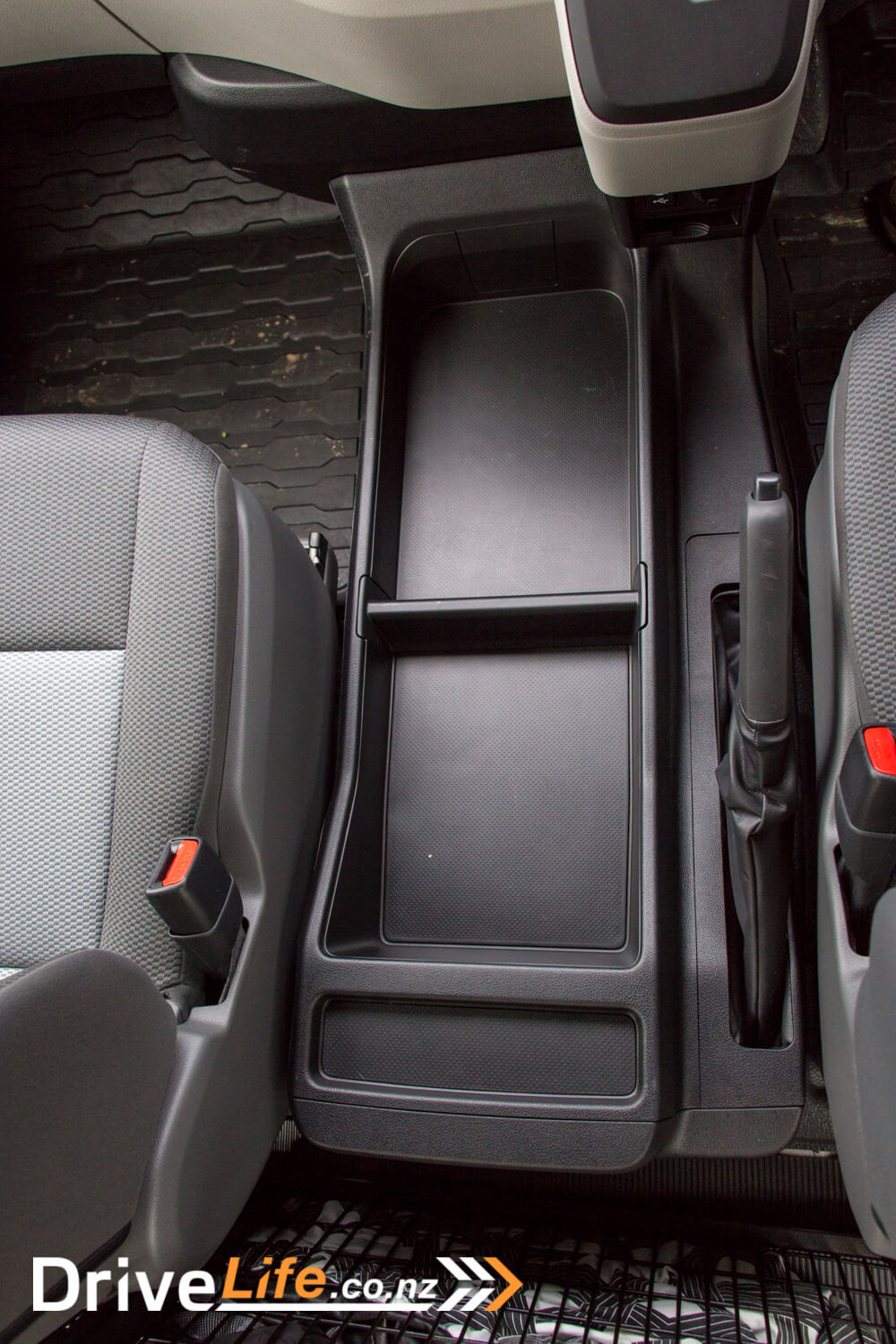
Up high, there’s a massive amount of storage on the roof for those log books, order books, magazines and empty pie packets that tradies and couriers carry about. It’s fairly solid too, and while no specs are given, there’s a fair few litres of space up there.
Opening the massive side door, there’s room for a party in the back of the Hiace. Not that the previous model wasn’t spacious, but all who saw the Hiace couldn’t believe how big the rear was. With the move to a new design, the wheelbase has been lengthened, allowing for a longer and wider cargo area. You can fit over 9 cubic metres of stuff in the back of the Hiace.
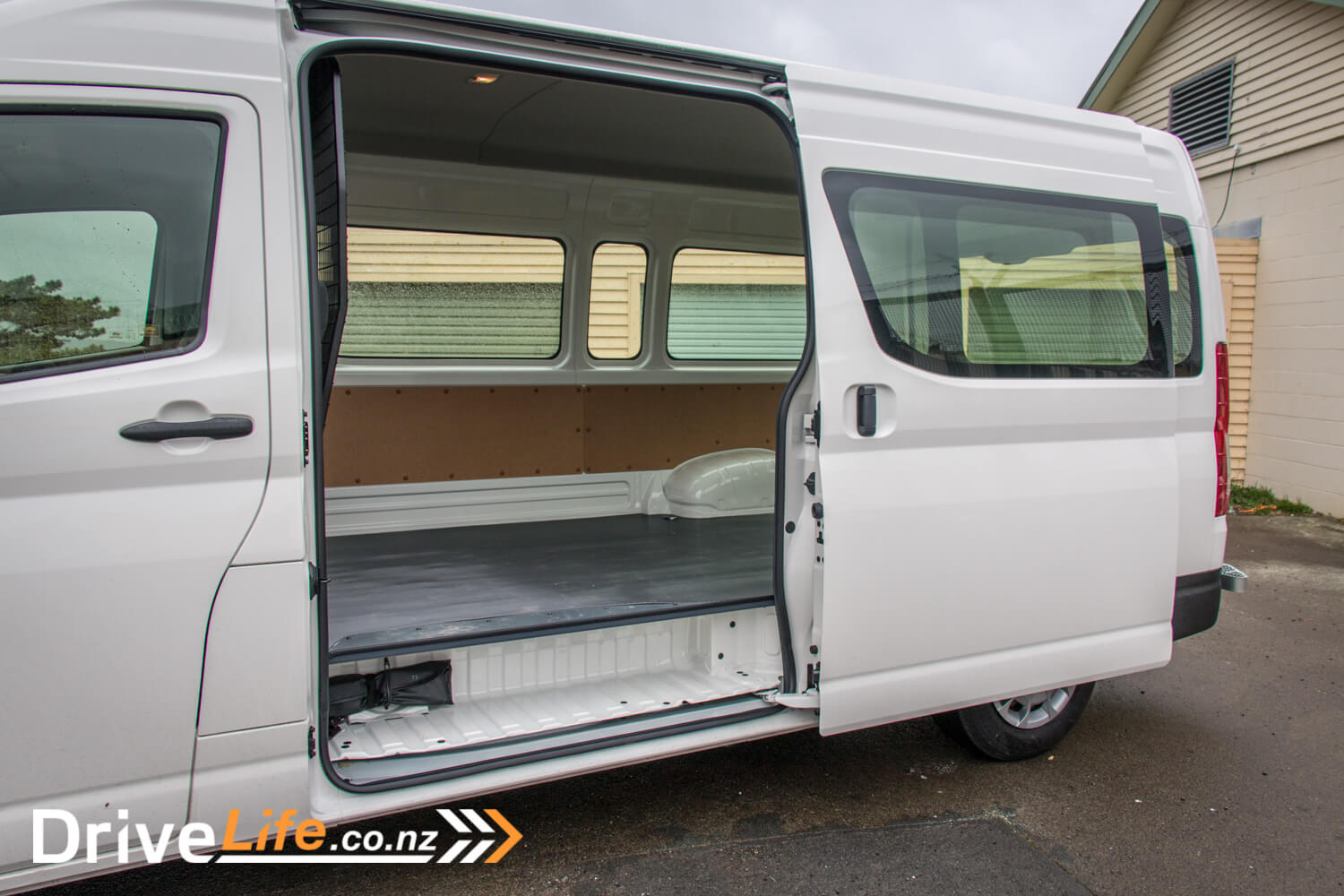
The Drive
For van buyers, there’s some essential requirements that must be met. One of these is visibility, and the Hiace scores almost top marks here. Since our test van had side windows all round, visibility was excellent, and then add into that dual lens mirrors, blind spot monitoring and that huge front windscreen, and doing deliveries in the Hiace should be a breeze. One small mark against visibility is the flaring out of the A pillars at the base, where they start to move towards the bonnet. The flaring isn’t massive, but it does cut down on your ability to see anything on the other side of the A pillar if the angle is wrong.
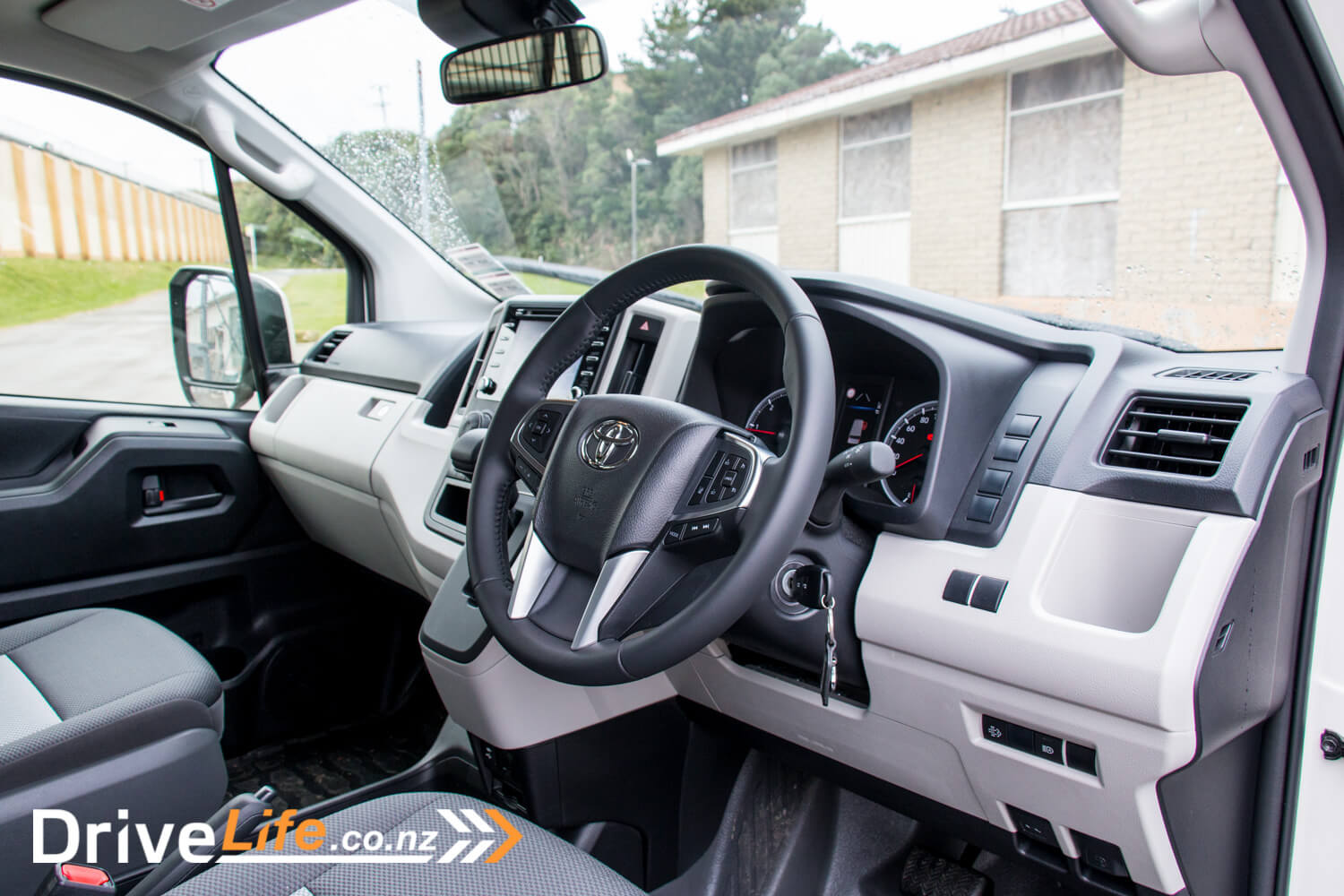
I’m guessing a second requirement would be ease of access, and the new Hiace scores pretty well here too. The side door in particular is massive, like they’ve put a ruler along the van, and marked half way, then made the side door a full half length. It’s truly long, and makes chucking stuff in from the side of the road a breeze. Both front doors are pretty long too, and being so high up opening them when near another car means the edge of the door can often clear the bonnet on the car parked next to you. The actual length of the interior of the new Hiace is over a half-metre longer than the previous one.
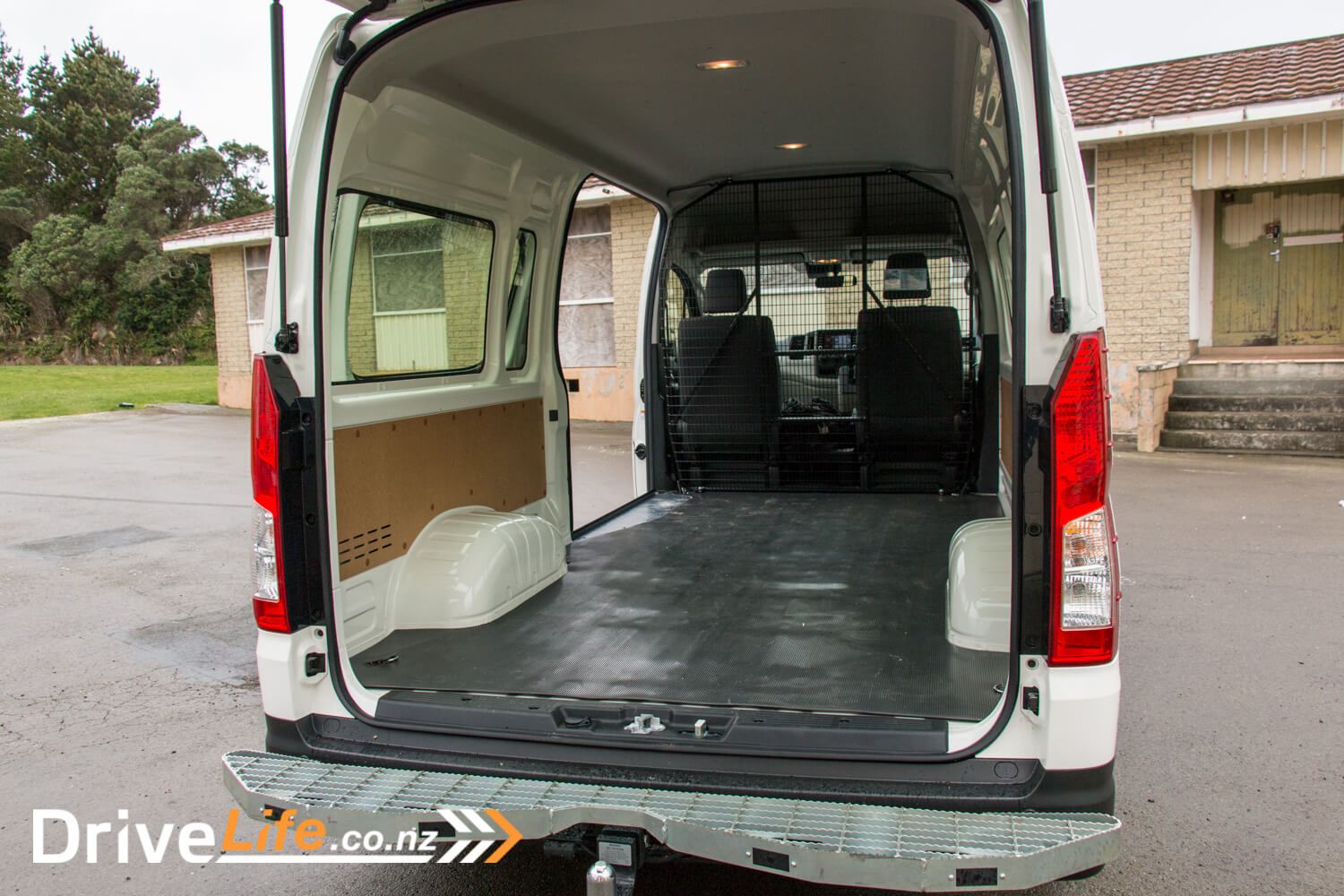
The rear door opens wide and high too, and the floor is relatively low. The wheel arches don’t intrude too much into the cargo area.
Number three of the ‘have to haves’ list is surely driveability, and this is where the Hiace really shines. Sure, it’s freaking long and tall, but after a few days behind the wheel it feels a whole lot smaller, as you start to chuck it about a bit more. The steering wheel in particular is a more of a car-like angle, so it does feel like you are driving a car, more so than a bus.
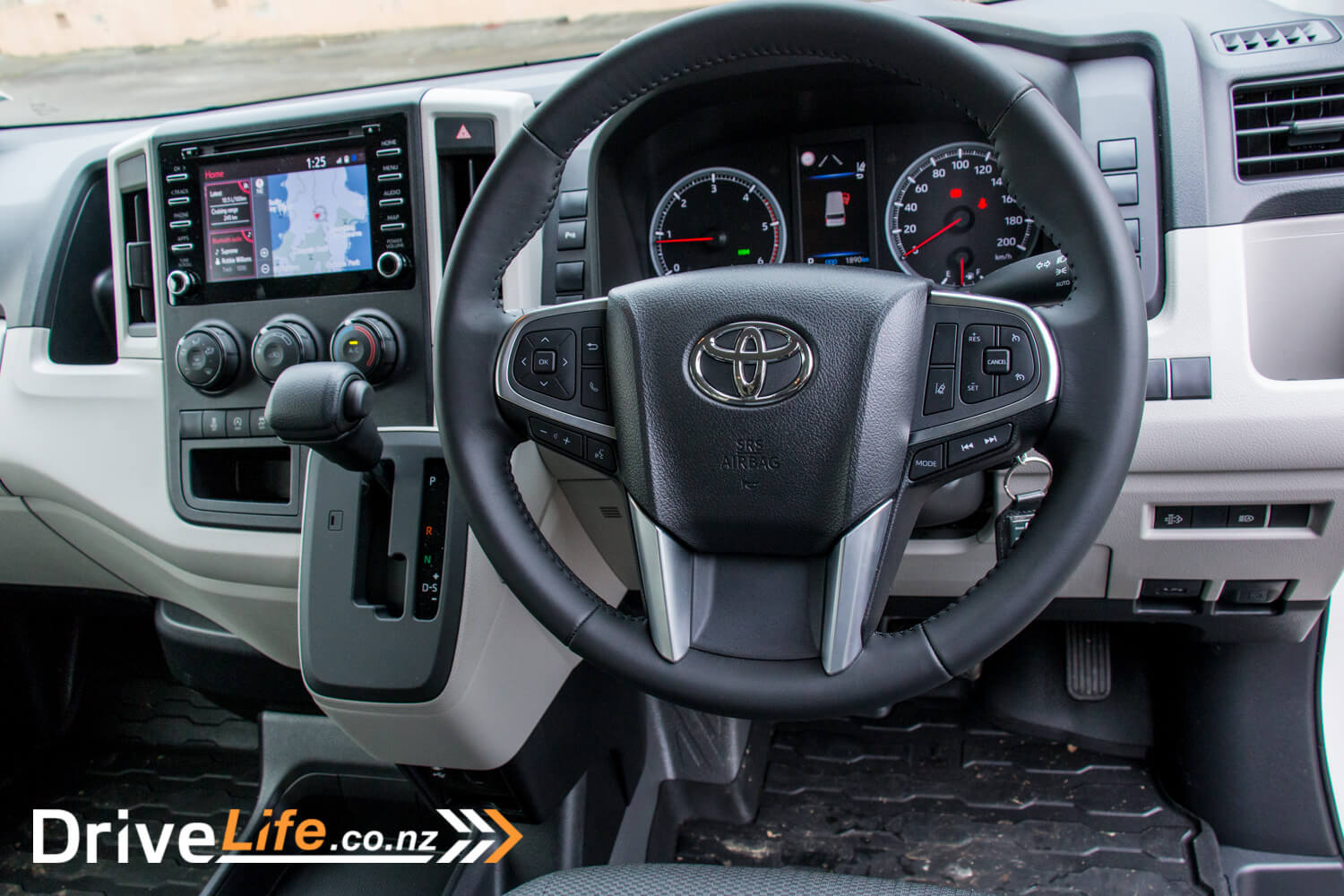
That 2.8 turbo-diesel cruises very nicely, a little noisy at times since there’s so much less insulation than you’d get in say an SUV, but it’s not too bad. On the motorway, it’s a subdued diesel engine noise you hear, with an occasional diff whine on a trailing throttle. But for the day-to-day, the Hiace is a really nice van to drive, to the point where I forgot it was a van at all, and more simply a vehicle to get from A to B in.
My week with the Hiace included some crap weather – heavy winds and rain. Still rear-wheel drive, the Hiace took it all in its stride. I had some concerns about the van when I used it empty nearly the whole week, but it impressed me. An emergency stop at traffic lights on a wet motorway didn’t see the rear end skipping about like I thought it might – the van just stopped, no drama. Even heavy winds on the motorway didn’t upset it as much as I thought it would, especially with that long body facing the wind.
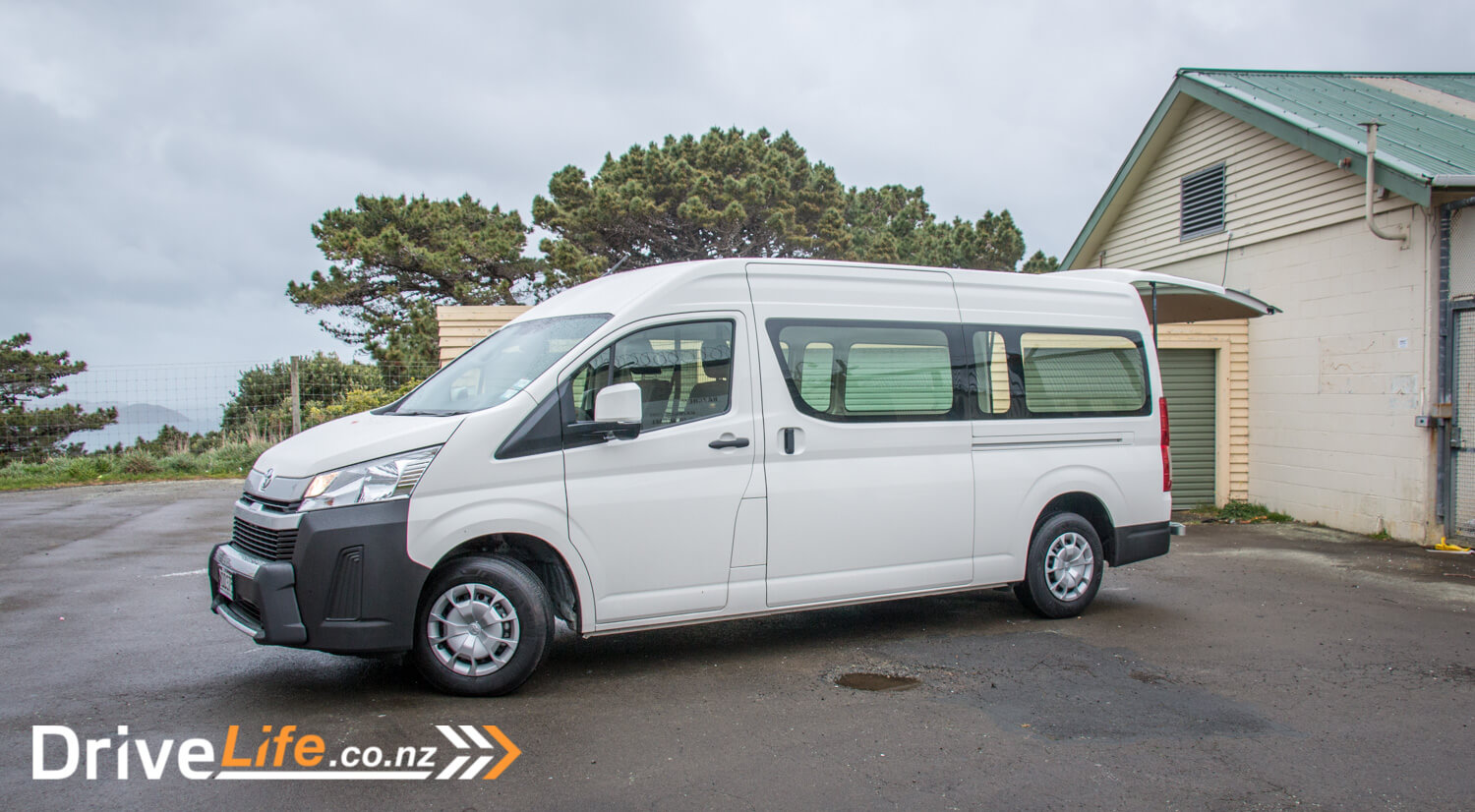
Since I had the van nearly empty the whole week, you’d be thinking it would ride like a pig. Sometimes with vans and utes, we have to put a bag of cement or just *something* in the rear to make them ride without bouncing around. Not so the Hiace – it rides extremely well, empty or not. This was one of the highlights for me for the van, I was really expecting it to get a bit wearing, bouncing around, but it just doesn’t.
The new-to-the-Hiace engine has 30kW more power than the previous gen (max 130kW), and an excellent 150Nm more torque than the previous gen (max 450Nm in the automatic). Manual transmission Hiaces with the new engine have slightly less torque at 420Nm – up 120Nm.
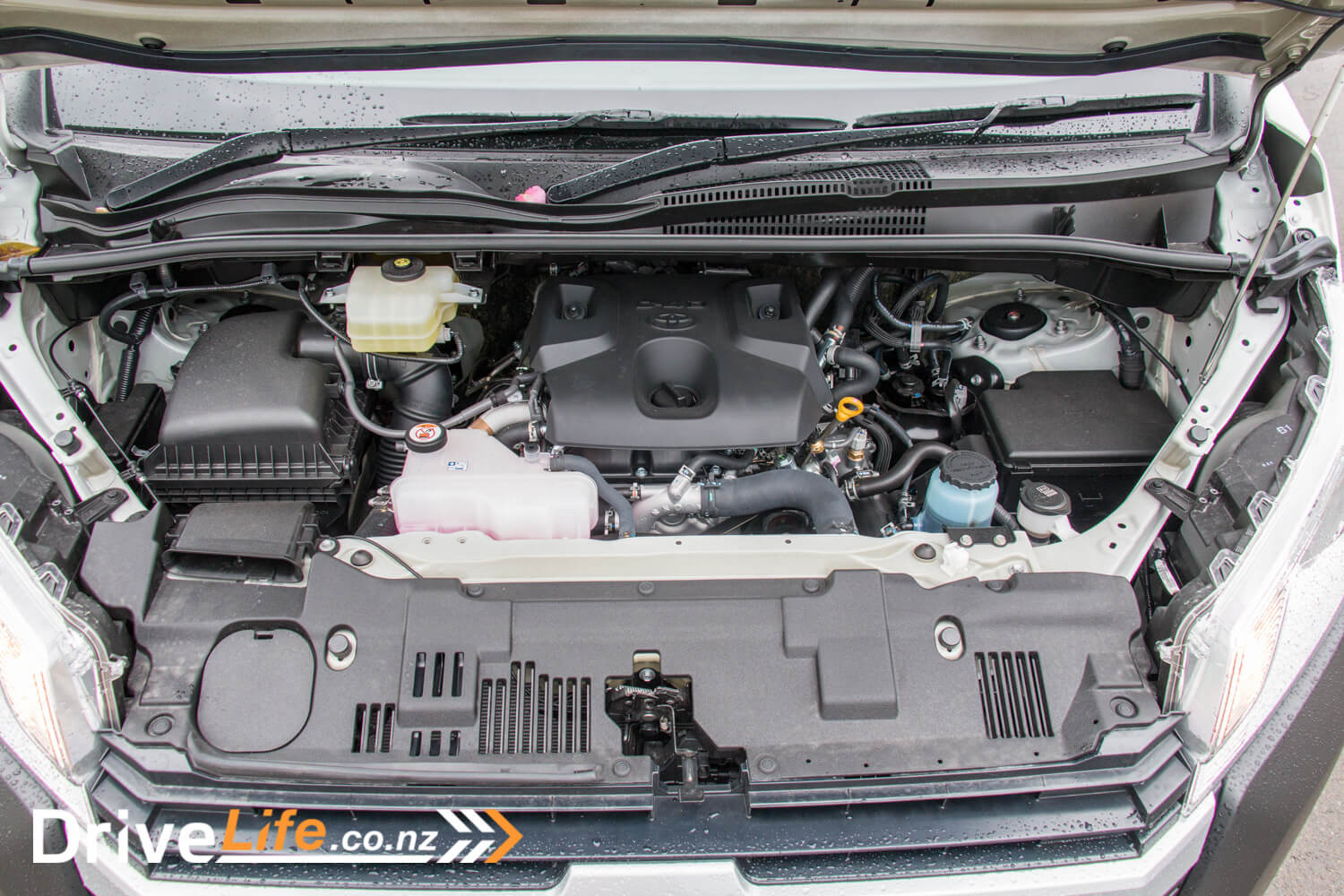
Still on the Daily Drive, the dual-lens mirrors are huge – but about the same as other vans, so I guess I’m comparing them to a car. They’re power folding too, which is a nice touch, but such a shame they don’t auto fold when you lock the van.
The more time I spent with the Hiace, the more I realised Toyota have really thought about this as being something that isn’t just a tool to move stuff (or people) and instead focused on making it as simple and as safe as possible to drive. Examples? The sun visors are massive, going almost right to the centre of the windscreen, so you can really block out that annoying sun from the side if you want to.
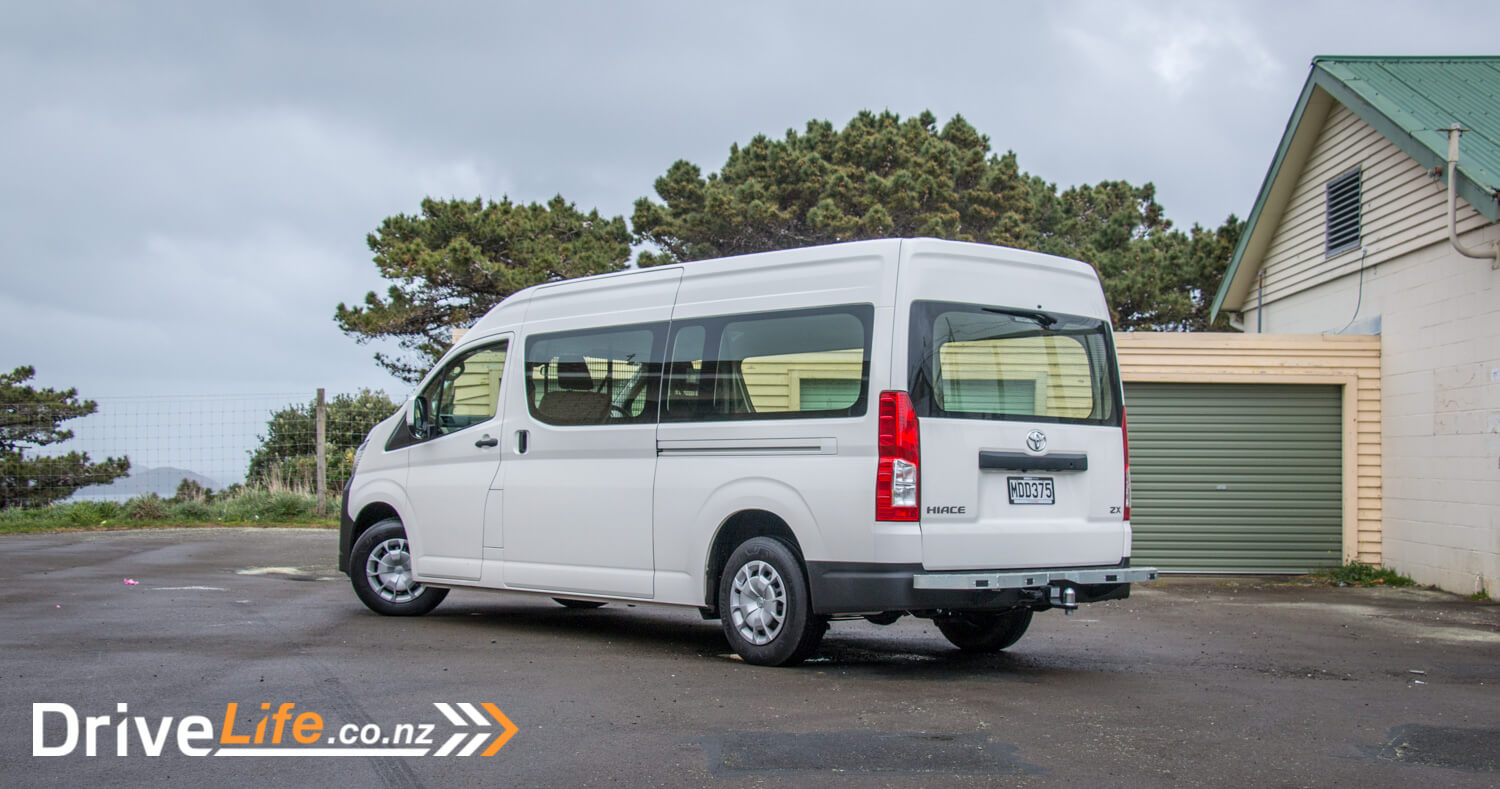
Cruise control is not adaptive, but it does apply the brakes going down a hill, and this is always the next best thing to having adaptive cruise. Too many cars (i.e. most of them) that don’t have adaptive cruise don’t brake down a hill.
Other nice easy-drive touches are the AC controls; the AC isn’t climate controlled, but it’s all managed by three simple dials, and that’s it, and that’s how it should be. Both front windows are auto up/down, and for those plumbers wanting to crank up the AC/DC, there’s still a CD player.
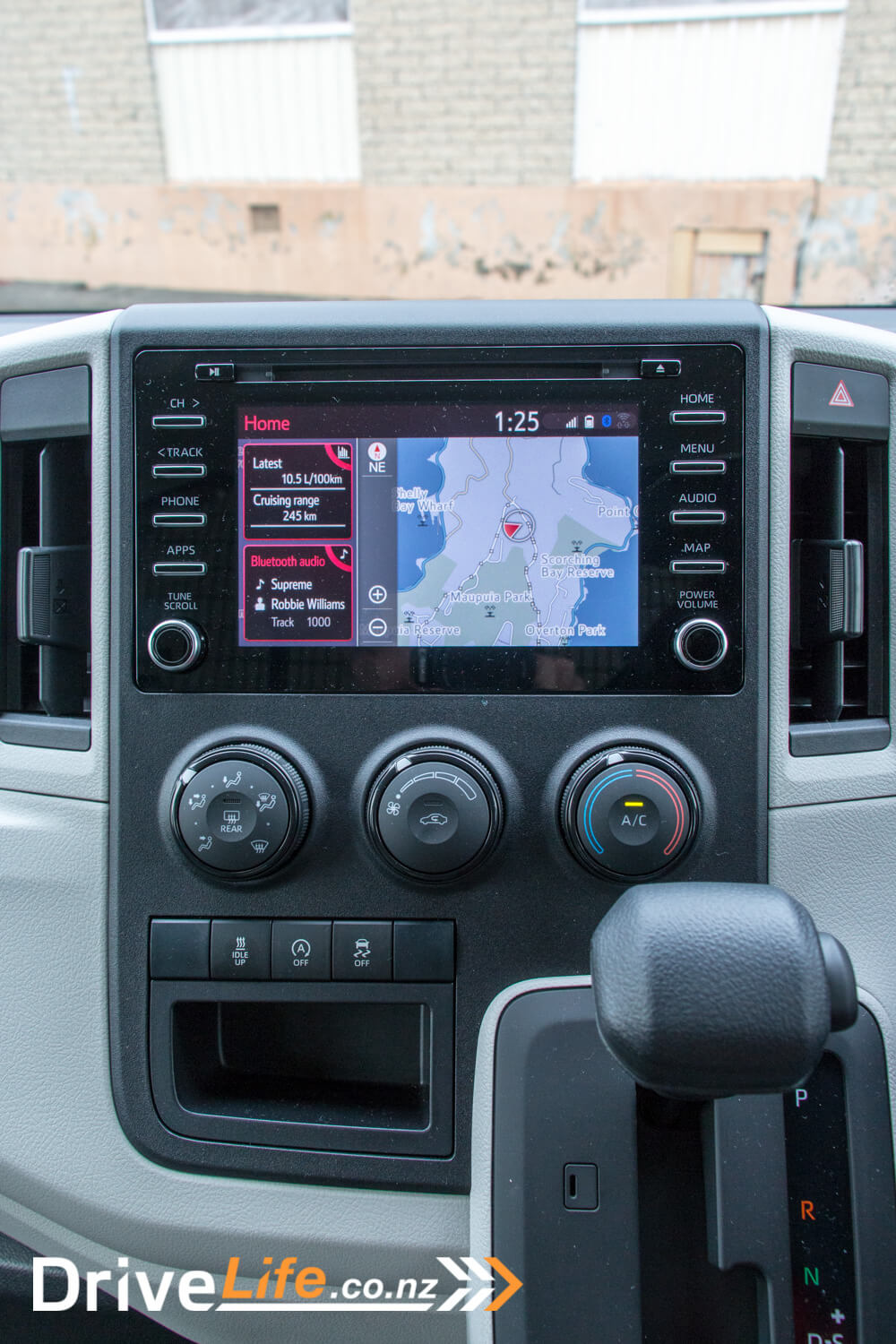
Speaking of the CD player, the audio quality is better than you’d expect for just having front speakers. As usual, you can control audio from the steering wheel or the 7” central display. The central display buttons weren’t my favorite thing; they’re raised buttons, with the label for the button above it. But the label itself was bigger than the actual button, so my brain made me keep pressing the word (like, Audio) instead of the hard button. I remembered in the end, but wonder why Toyota didn’t just make the entire label a button. Some tradies who drive occasionally with gloves on would appreciate that, I’m sure.
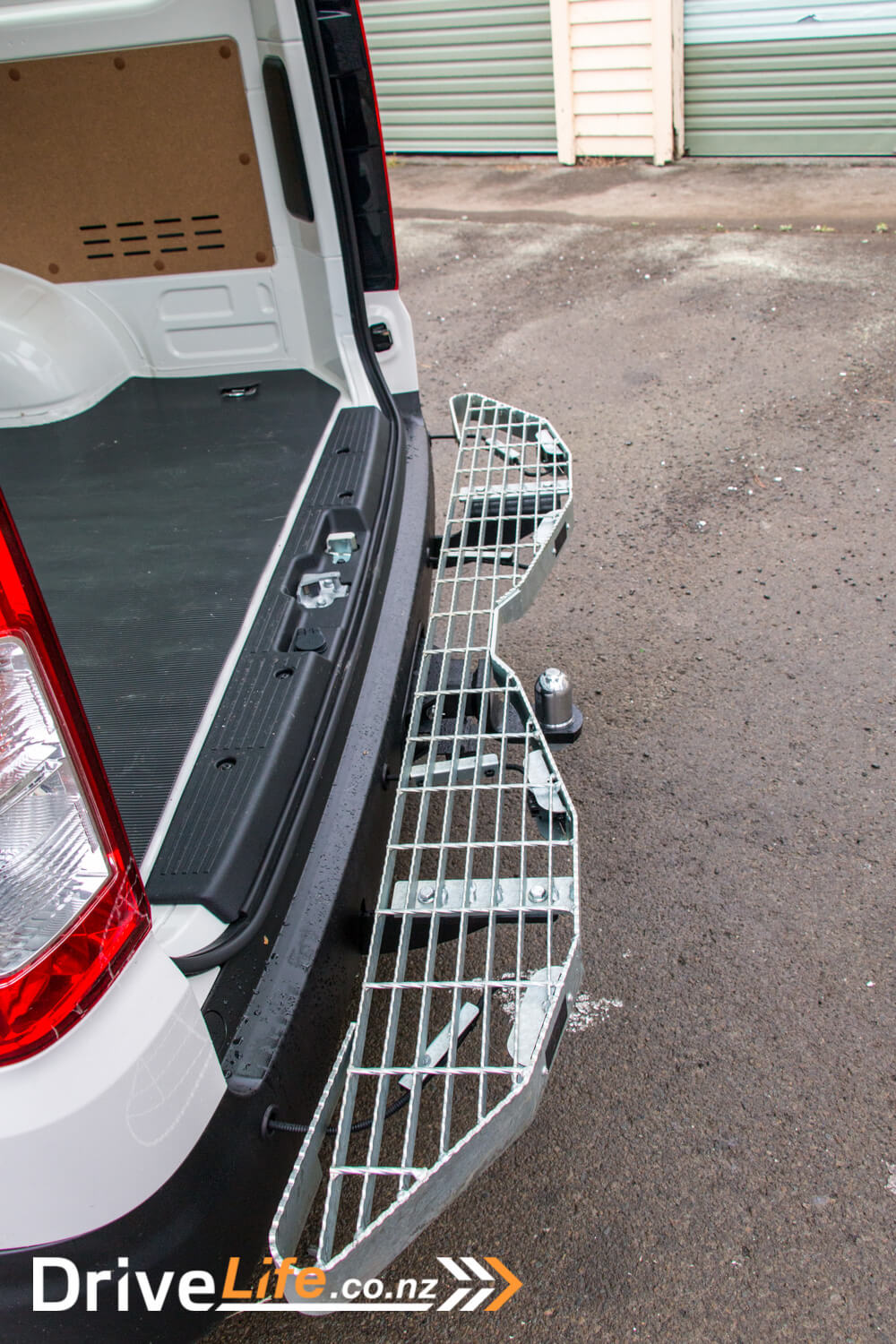
From the driver’s seat, there’s a leather steering wheel that feels great, and makes the Hiace feel even more like a car. The dashboard is simple and clear, and it was great to see a digital speedo smack dead centre of the Driver’s Information Display (DID). You can flick between the usual options on the DID using the steering wheel controls, like fuel economy, phone, audio, SatNav directions, and vehicle options.
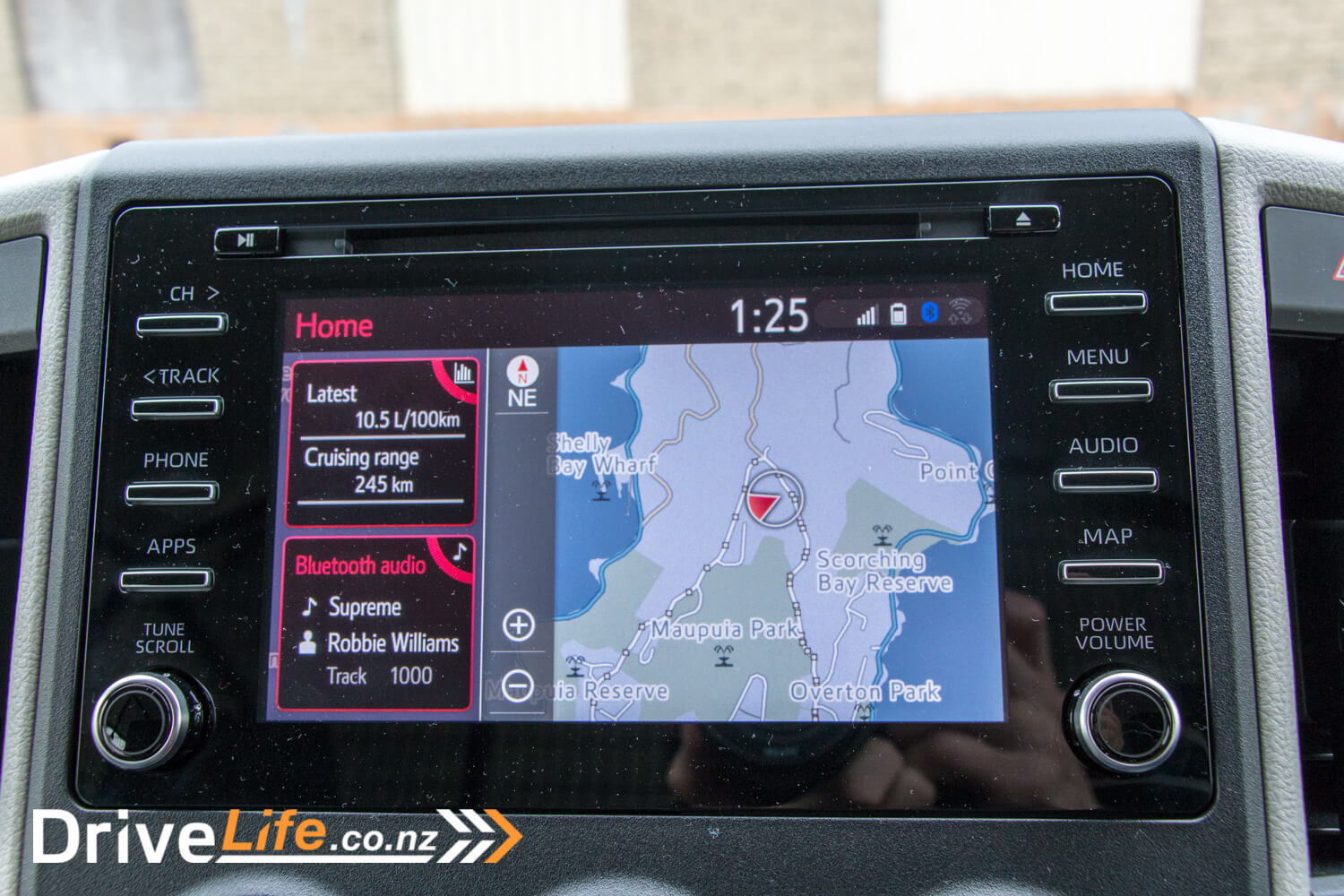
I know it’s mentioned in The Range, but hats off to Toyota for including such a long list of safety features for a van. The new model Hiace includes Toyota Safety Sense consisting of Pre-Collision System with Autonomous Emergency Braking and vehicle, bicycle and pedestrian detection. It also has Lane Departure Alert with brake control (Yaw Assist) and vehicle sway warning, Road Sign Assist and Automatic High Beam. Other safety features include Trailer Sway control, Blind Spot Monitor and Rear Cross Traffic Alert. There’s also a reversing camera, and front and rear parking sensors.
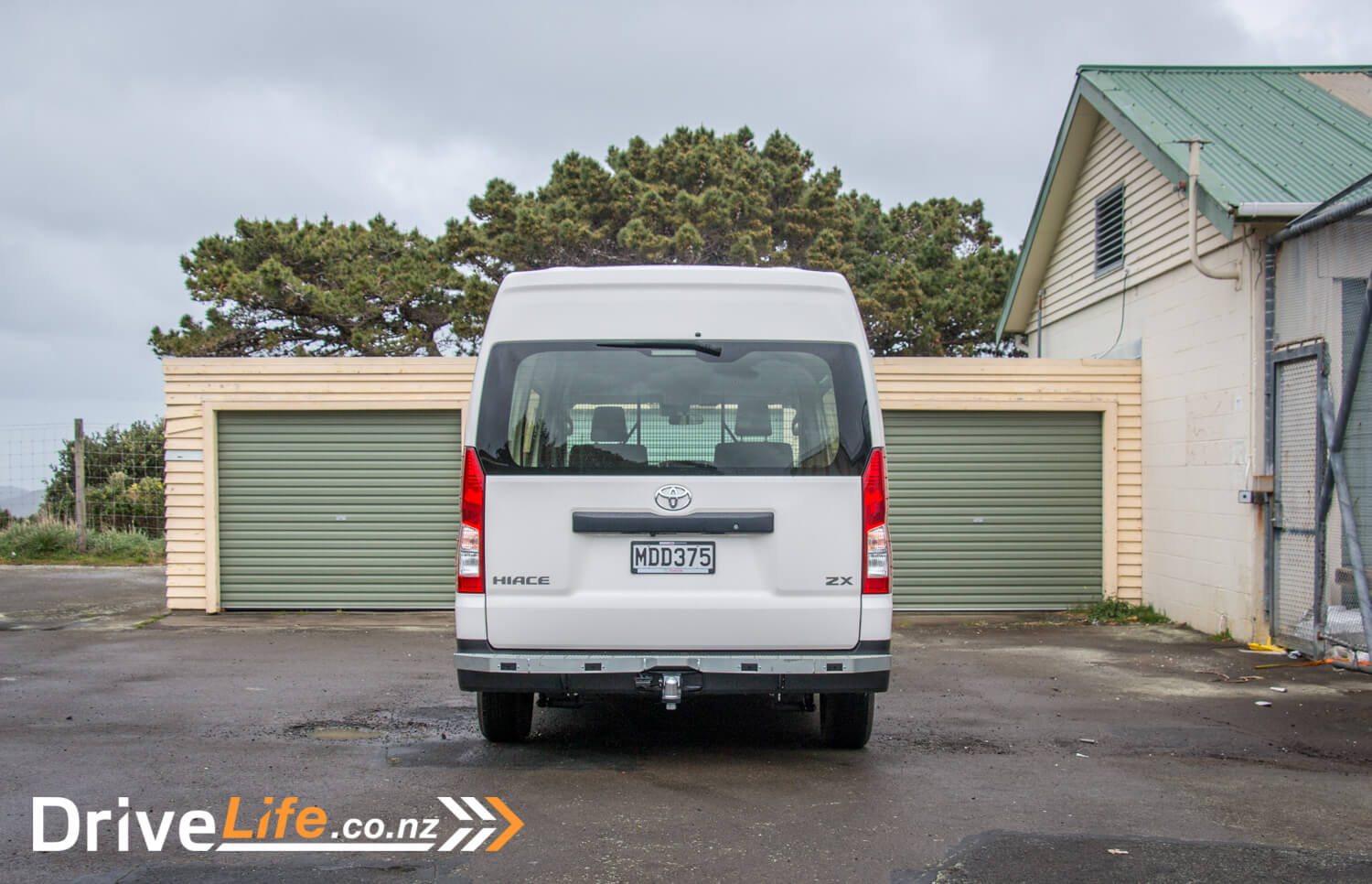
Great to see Toyota have made SatNav standard across the range, along with SUNA Traffic Alerts – essential for a busy courier. SatNav directions are also shown in the DID, and works a treat. Traffic Sign Recognition is included as standard too, shown in the DID. I love this feature, and glad to see it made it to a van.
You’d be thinking that the Hiace is near-on perfect if you’ve read this far. Well, not quite. There were a few things that stood out as not right (for me), or just annoying. One of these – the main one if I’m being honest – is the verbal warning that crops up randomly. You are driving along, maybe listening to music, or on a phone call, when an announcement is made: “Please obey all traffic regulations”. Two hundred metres up the same road, you get it again. Then not at all for five minutes, then again. I thought maybe it was linked to my speed, but it did this when traveling under the speed limit. I had people on the phone who would ask who was with me.
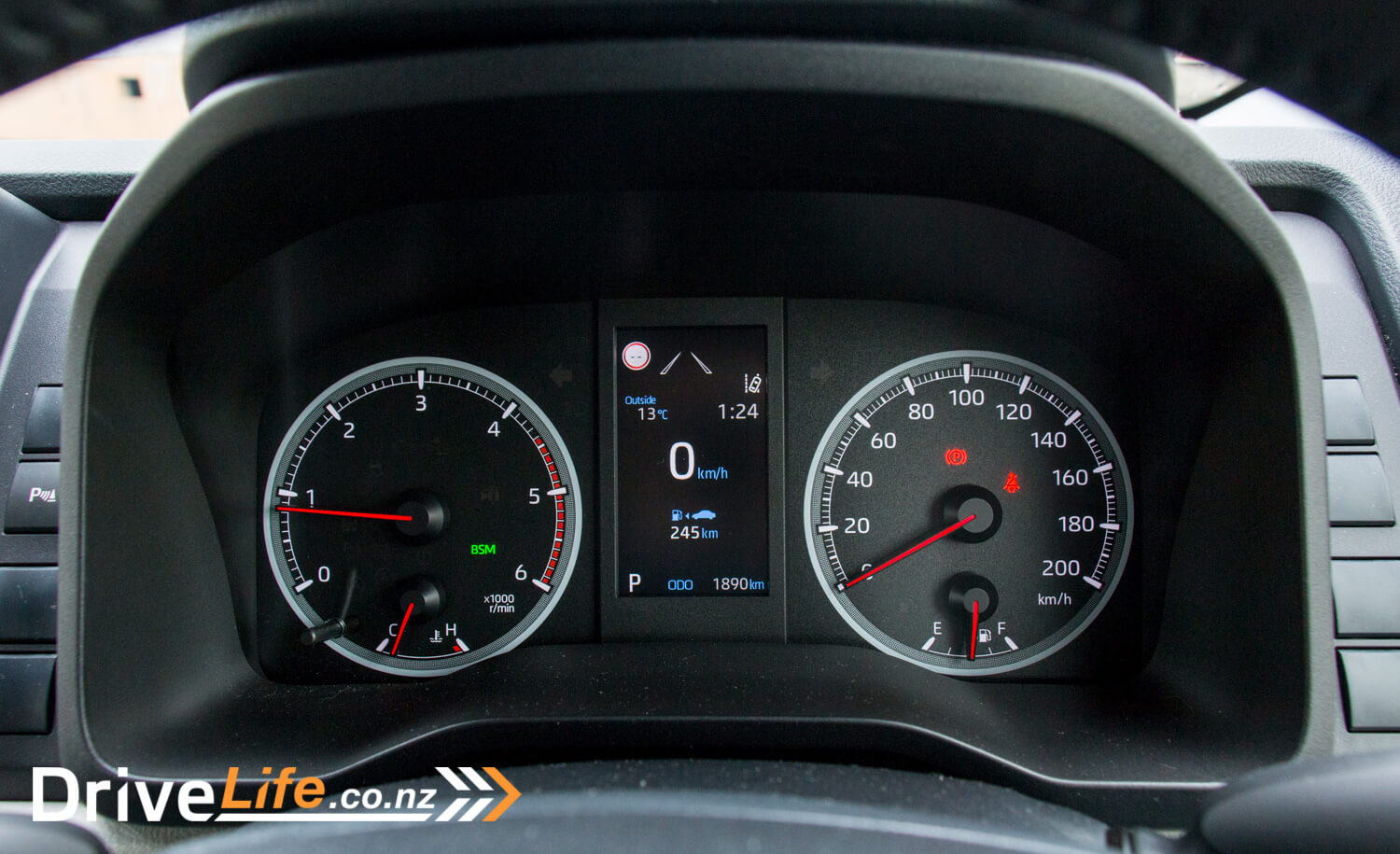
Simple you say, just turn it off. I went through the menu system, and couldn’t find anywhere to turn this feature off. I could see a few electricians attacking the speakers with a screwdriver over this one. It can get annoying, then it moves from annoying to white noise and you zone the voice out, which I’m guessing defeats the purpose of it.
My other usual) bug bear: The Hiace has an engine auto-stop feature, which is fine. You might be at the lights, and a message on the DID will tell you to “press brake harder to activate”. So you press the brake pedal a bit, and the engine turns off. Great! Of course, unless you are going to be at the lights, so you pull the handbrake on and release the brake pedal, then the engine starts. Yes, it’s this scenario, the same that we’ve seen in so many cars. It makes the auto-stop feature a bit pointless if you can’t keep the engine off when you are going to be stationary for a while. In some cars, you can shift it to Neutral or Park first, and then the handbrake, and the engine will stay off. Not so in the Hiace – as soon as you move the gear lever, the van starts again. Bummer.
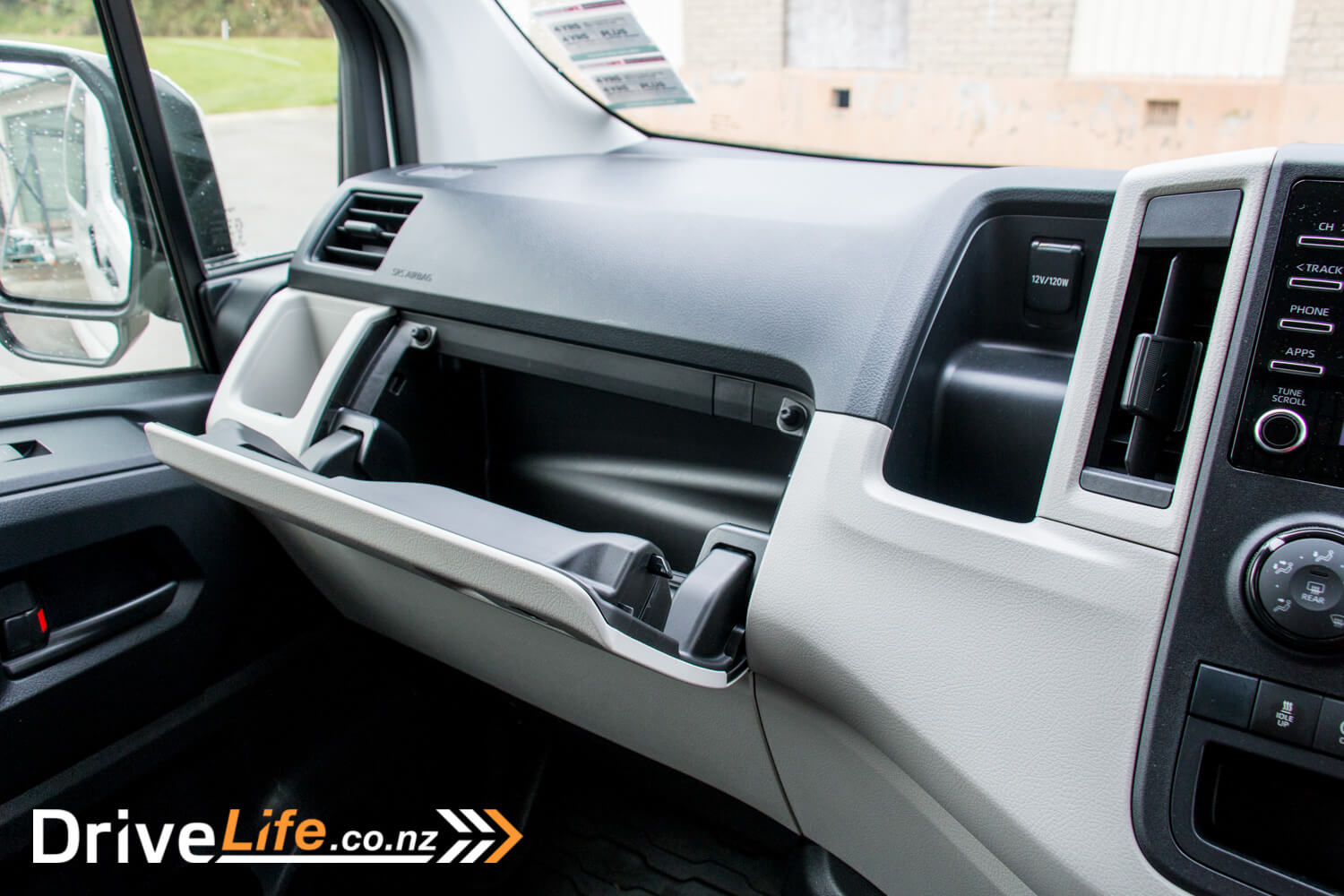
Another surprise for me was the number of blank switches. We’re used to seeing a few, maybe half a dozen or so. The Hiace – even in the top-spec ZX model – has 16 blank switches. It made me feel like I’d been cheated a little, wondering what I was missing out on. Not the end of the world though.
You do get a single USB and 2 x 12-volt sockets up front though, so that’s handy, although I’m sure most tradies would want at least 2 USBs.
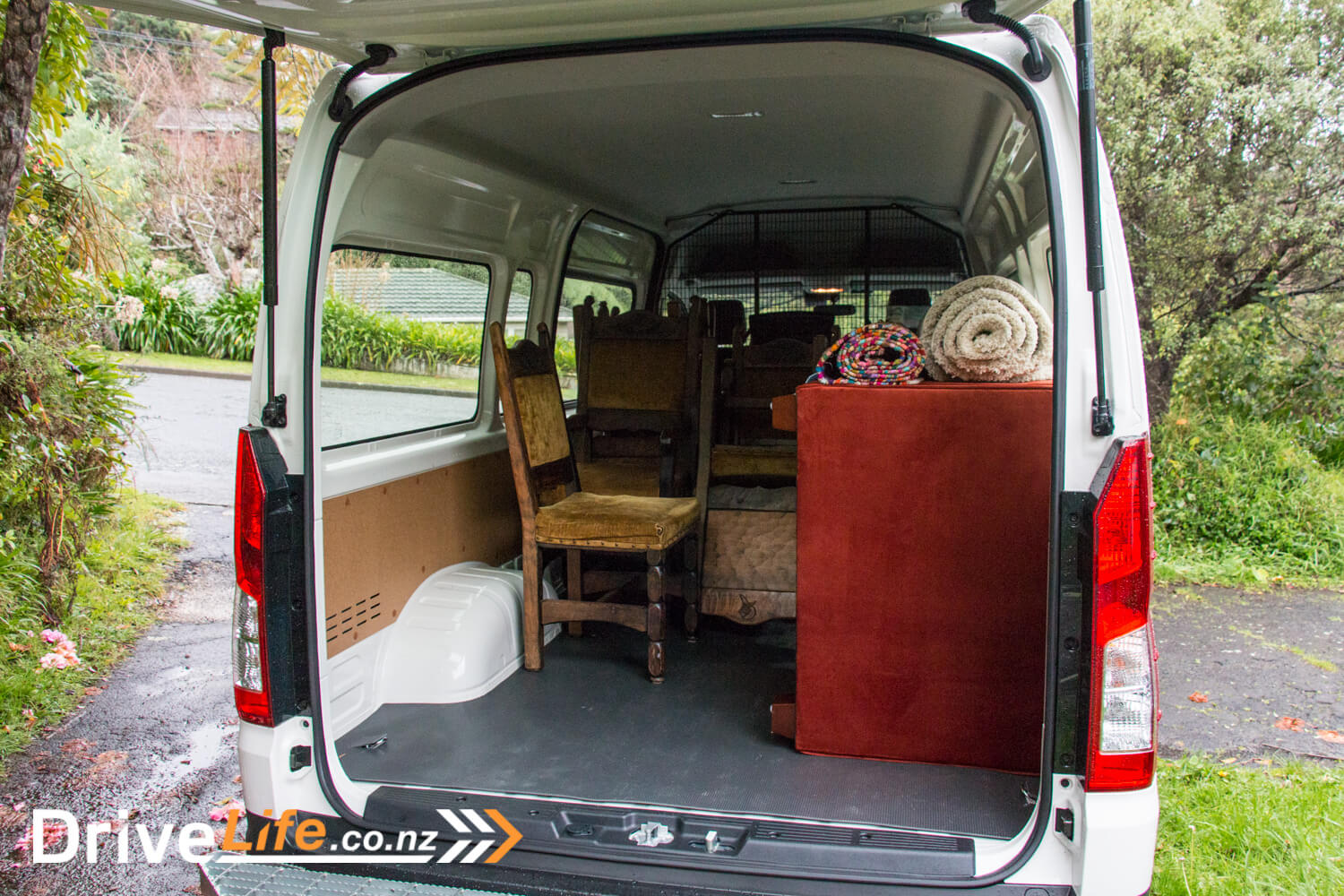
One more thing for me that I didn’t quite like – and haven’t on other cars either – is the split audio controls on the steering wheel. For the Hiace, that means volume up/down on the left side of the wheel, and track/station change on the right. The OCD in me wants them to be on the same side. It still works, but even after a week if I wanted to change a track, my left hand would naturally go to that side of the wheel, but it was the wrong side. Again, not the end of the world, and would probably mean nothing to most right-in-their-brain people.
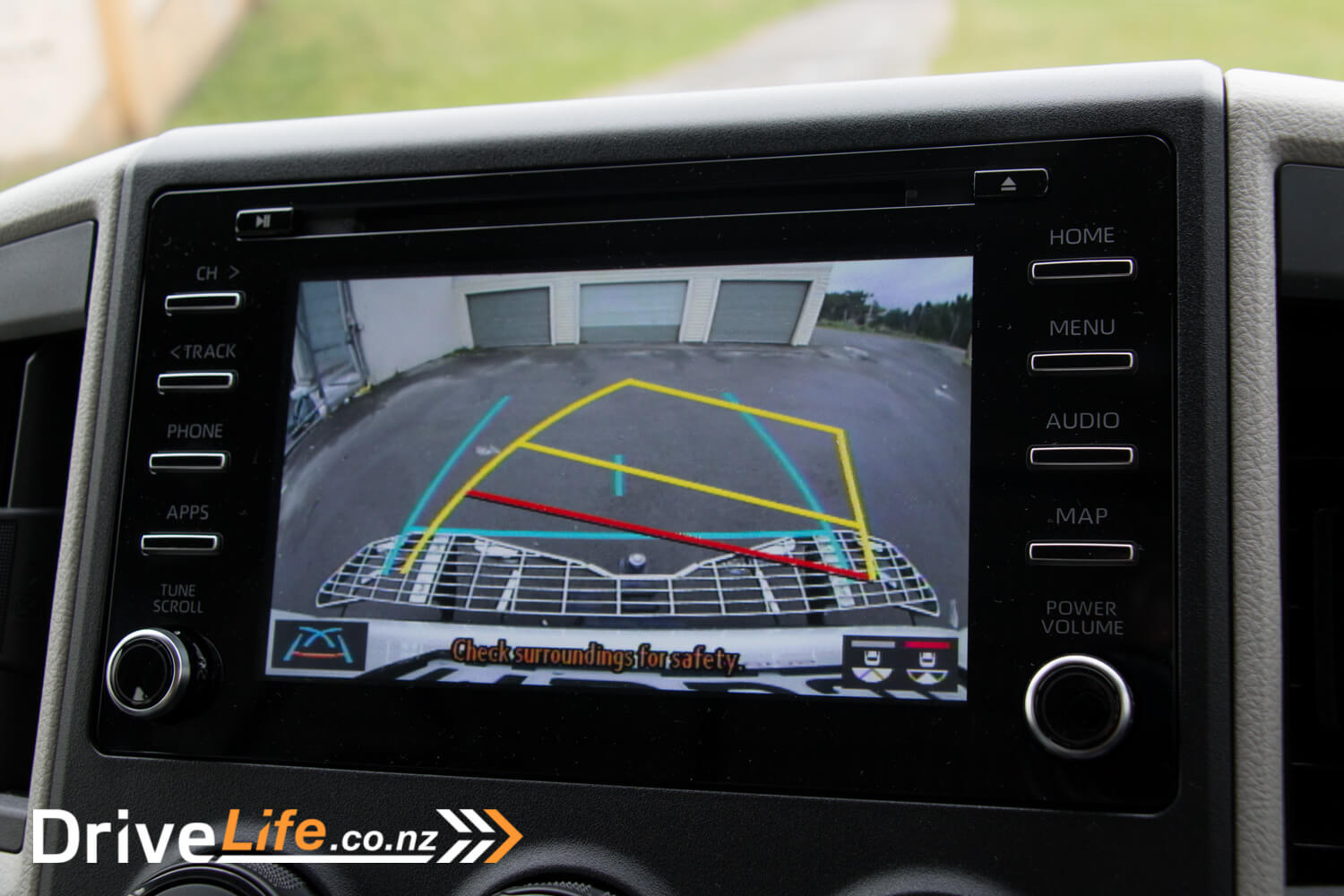
Last thing I didn’t like, or didn’t think fitted in with what Toyota have strived to achieve; there’s no keyless entry or keyless start. You might think this is luxury, but I expect for courier drivers or even tradies who just want to get moving, getting the keys physically out of your overalls to unlock it, then having to stick the key in the ignition, is just annoying.
Back to things I did like. The cloth seats are comfy as, and at last there’s a height-adjustable driver’s seat. There’s so much space up front, you can really stretch out. Nice to see three (?) big cup holders up high on top of the dash, big enough for water bottles, and more bottle holders in the doors.

It was also fantastic to see there’s no ‘off’ position for the headlights, and this is the first time I’ve seen this. Your only options are Automatic, Park lights, and Headlights. Since New Zealanders seem to struggle so much with turning their headlights on when they should, this can only be a good thing.
Fuel economy might not be the Hiace’s strong suit though. For my week and 600km (90% empty), it used 10.5L/100km. Toyota suggests 8.4.

The Competition
| Brand/Model | Engine | Power/TorquekW/Nm | Number of seats | Cargo capacity, cubic M | Fuel L/100km | Base Price – High to Low |
| VW Transporter LWB High Roof | 2.0-litre diesel twin turbo | 130/410 | 3 | 14.4 | 8.0 | $76,500 |
| Ford Trasnsit Custom LWB High Roof | 2.0-litre diesel turbo | 125/405 | 3 | 13 | 7.6 | $61,990 |
| Toyota Hiace ZX | 2.8-litre diesel turbo | 130/450 | 2 | 9.3 | 8.4 | $50,990 |
| Hyundai iLoad | 2.5-litre diesel turbo | 125/441 | 3 | 4426 (litres) | 8.8 | $50,990 |
| LDV V80 Biggest | 2.5-litre diesel turbo | 100/330 | 3 | 11.6 | 9.4 | $40,990 |
The Pros and Cons
| Pros | Cons |
| Ride when empty Drives so well Visibility Access So much room up front and cargo aeaa Standard safety equipment Standard SatNav | Engine auto-off functionality No keyless entry/start Road safety announcements· |
The Verdict
It’s hard not to like the Hiace ZX. It does exactly what is says on the packet; takes a whole lot of stuff in the back, and drives beautifully (for a van).
Sure, I had a few niggles, but what car doesn’t? And this is a van, you’d expect to make some comprises there. But as I said, I forgot I was driving a van after a while, it just felt so normal.
The more I look at the photos of the new Hiace, the more I don’t like the new look, but here’s the thing: you can’t see it when you are driving it, so who cares?

2019 Toyota Hiace Z
4.0 Chevrons
| Vehicle Type | 4-door large van |
| Starting Price | $44,990 |
| Price as Tested | $50,990 |
| Engine | 2.8-litre, 4-cylinder DOHC diesel turbo |
| Transmission | 6-speed automatic |
| Power, TorquekW/Nm | 130/450 |
| Spare Wheel | Full size |
| Kerb Weight, Kg | 2,330 |
| Length x Width x Height, mm | 5915x1950x2280 |
| Cargo Capacity, litres | 9,300 |
| Fuel Economy, L/100km | Advertised Spec – combined – 8.4 Real World Test – combined – 10.5 Low Usage: 0-6 / Medium Usage 6-12 / High Usage 12+ |
| Fuel tank capacity, litres | 70 |
| Towing CapacityKg, unbraked/braked | 400/1,900 |
| Turning circle, metres | 13 Small: 6-10m / Medium 10-12m / Large 12m+ |
| Warranty | 3 years, 100,00km |
| ANCAP Safety Ratings | 5 Star |










































